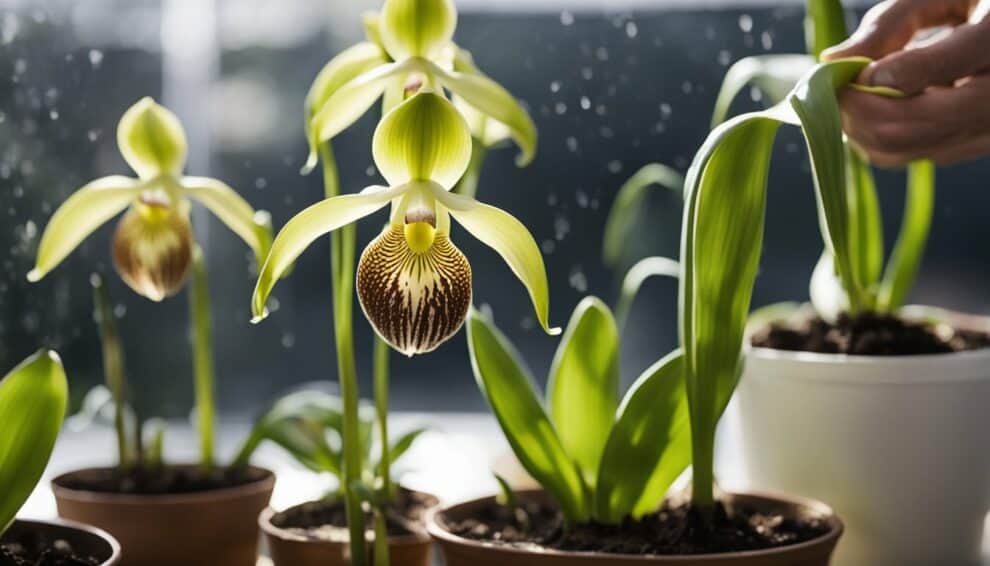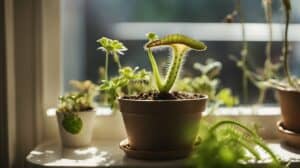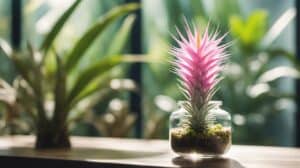Lady Slipper Orchids, also known as Paphiopedilums, are a popular choice for orchid enthusiasts due to their unique and striking appearance.
These orchids are native to Southeast Asia and are known for their pouch-shaped lip, which resembles a slipper.
Lady Slipper Orchids are relatively easy to care for and can be propagated through several methods, including division, seed sowing, and tissue culture.

Propagation is an essential aspect of Paphiopedilum care and cultivation, as it allows growers to expand their collection and preserve rare or endangered species.
Division is the most common method of propagation and involves separating the orchid into smaller sections, each with its own set of leaves and roots.
Seed sowing is another popular method, although it requires more patience and specialized equipment.
Tissue culture is a more advanced method that involves growing orchids in a sterile laboratory environment.
In this article, we will explore the various methods of Lady Slipper Orchid propagation and provide tips for successful care and cultivation.
Whether you are a seasoned orchid grower or a beginner, this guide will help you expand your collection and enjoy the beauty of these unique and fascinating plants.
Understanding Lady Slipper Orchids
Species Overview
Lady Slipper Orchids, also known as Paphiopedilums, are a popular orchid species that are native to Southeast Asia, the Pacific Islands, and parts of India.
There are approximately 80 recognized species of Lady Slipper Orchids, with many different hybrids and cultivars available in the market.
These orchids are known for their unique slipper-shaped pouch, which is used to trap and hold pollinators.
The pouch is also used to store water and nutrients, making these orchids well-suited for growing in low-nutrient environments.
Lady Slipper Orchids come in a variety of colors, including shades of green, yellow, pink, and purple.
Natural Habitat
Lady Slipper Orchids are typically found growing in the wild in shaded areas of tropical forests, where they receive filtered light.
They are epiphytic, meaning they grow on trees, and are also found growing on rocks and in soil.
These orchids prefer warm and humid conditions, with temperatures ranging from 60 to 80°F (15 to 27°C) and relative humidity levels of 50% or higher.
In their natural habitat, Lady Slipper Orchids receive nutrients from decaying organic matter and rainwater.
They are also pollinated by insects, including bees, wasps, and flies.
These orchids have adapted to their environment by developing specialized roots that allow them to absorb nutrients and water from their surroundings.
Understanding the natural habitat of Lady Slipper Orchids is important for successfully growing and caring for these beautiful orchids.
By replicating their natural environment, gardeners can ensure that their Lady Slipper Orchids thrive and produce beautiful blooms.
Propagation Techniques

Lady Slipper Orchids, also known as Paphiopedilum, can be propagated through two methods: division and seed germination.
Division
Division is the process of separating the plant into smaller parts, each with its own roots and shoots.
This method is typically used for mature plants that have outgrown their current pot or when the grower wants to increase the number of plants they have.
To divide a Lady Slipper Orchid, gently remove the plant from its pot and carefully separate the roots and shoots.
It is important to ensure that each new plant has enough roots to support itself.
Once separated, each new plant can be potted into its own container with fresh potting mix.
Seed Germination
Seed germination is another method of propagating Lady Slipper Orchids. This method is often used for hybridization and breeding purposes.
To germinate Lady Slipper Orchid seeds, the seeds must be sown onto a sterile, moist growing medium and placed in a warm and humid environment.
The seeds will typically germinate within 4-6 weeks, and once they have grown large enough, they can be transplanted into their own pots with fresh potting mix.
It is important to note that seed germination can be a time-consuming and delicate process, and it may take several years for the plant to reach maturity and produce flowers.
However, this method can result in unique and beautiful new varieties of Lady Slipper Orchids.
Essential Care Tips

Watering Requirements
Lady Slipper Orchids require a consistent level of moisture to thrive.
Overwatering can lead to root rot, while underwatering can cause the leaves to wilt and dry out.
It’s important to water the orchid thoroughly, allowing the water to drain completely before placing it back in its pot.
The frequency of watering will depend on the environment, but a good rule of thumb is to water once a week during the growing season and once every two weeks during the dormant season.
Light and Temperature
Lady Slipper Orchids prefer filtered or indirect light, as direct sunlight can scorch their leaves.
The ideal temperature range for these orchids is between 60-80°F (15-27°C).
They can tolerate cooler temperatures, but extreme heat or cold can be detrimental to their health.
It’s important to keep them away from drafty areas and to maintain a consistent temperature.
Soil and Fertilization
Lady Slipper Orchids require well-draining soil that allows for proper air circulation. A mix of bark, perlite, and sphagnum moss is a good option.
Fertilization should be done sparingly, with a balanced orchid fertilizer applied once a month during the growing season.
Over-fertilization can lead to salt buildup in the soil, which can harm the orchid.
Common Pests and Diseases
Lady Slipper Orchids are susceptible to common orchid pests such as mealybugs, scale, and spider mites.
Regular inspection and treatment with an insecticidal soap can help prevent infestations.
Diseases such as root rot and bacterial or fungal infections can be caused by overwatering or poor soil conditions.
Proper care and maintenance can help prevent these issues.
Frequently Asked Questions

What type of potting mix is ideal for Paphiopedilum orchids?
Paphiopedilum orchids prefer a well-draining potting mix that is rich in organic matter. A mix of bark, perlite, and sphagnum moss is a good option.
It is important to avoid using soil or heavy potting mixes that can retain too much moisture and lead to root rot.
Can you explain the steps for propagating Lady Slipper orchids?
Propagation of Lady Slipper orchids can be done through division or seed sowing.
Division involves separating the plant into smaller sections with healthy roots and shoots, and repotting them in fresh potting mix.
Seed sowing requires patience and specialized equipment to ensure proper germination and growth.
What fertilizer should be used for Paphiopedilum orchids, and how often?
A balanced, water-soluble fertilizer with a ratio of 20-20-20 is suitable for Paphiopedilum orchids.
Fertilize every two weeks during the growing season and reduce frequency during the dormant period.
How can I encourage my Paphiopedilum orchid to bloom?
Paphiopedilum orchids require a period of cooler temperatures and reduced watering to initiate blooming.
Provide a temperature drop of 10-15 degrees Fahrenheit at night for 4-6 weeks and reduce watering frequency to encourage blooming.
What are the specific care requirements for Lady Slipper orchids?
Lady Slipper orchids require bright, indirect light and a humid environment to thrive.
Watering should be done when the top inch of soil is dry, and the potting mix should be well-draining.
Avoid exposing the plant to extreme temperatures or drafts.
Is it better for Paphiopedilum orchids to be tightly potted, or do they prefer more space?
Paphiopedilum orchids prefer to be slightly root-bound, so it is better to use a pot that is just slightly larger than the plant.
Repotting should be done every 2-3 years or when the potting mix has broken down and is no longer providing adequate drainage.













